Best dog foods for allergies 2024 according to pet owners and experts
Here are the best dog foods for allergies to help keep your best friend feeling healthy and happy at mealtime.

If your dog has sensitivities, you should try the best dog foods for allergies. Whether your pup is allergic to gluten or grain, chicken or dairy - there are lots of specially formulated recipes that can help.
Finding the right food for your pup isn’t the easiest task — especially when you have to take intolerances and allergies into consideration too. Whilst something might be the best dog food for one pooch, it might not be right for yours. That’s why you should always consult a vet who will help you find the perfect match.
If you decide to switch your dog’s diet, expert vet Dr. Joanna Woodnutt advises trialing it for eight to 12 weeks. “It can take this long before we notice an improvement in your pet’s symptoms, though this will vary between individuals. Some dogs with gastrointestinal allergy symptoms may improve as early as two to three weeks, whereas dogs with skin symptoms could take four to 12 weeks, according to some sources.”
With the help of real owners and their pups, we tested the best dog foods for allergies to save you time and money. Here our top picks:
The quick list
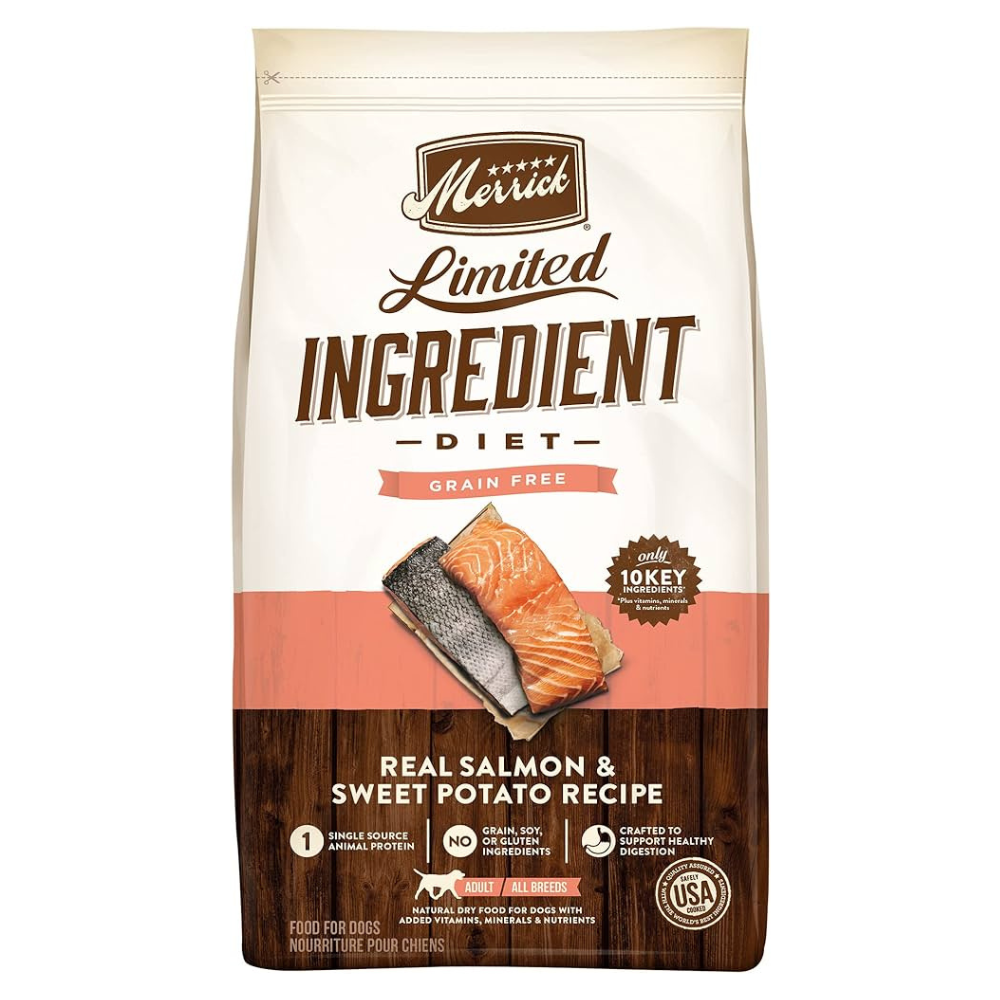
The best overall dog food for allergies
This dog food is great for pooches with allergies, thanks to the limited protein sources. It also contains fish oils and flaxseed (for omega 3 and 6) which work wonders for skin inflammation.
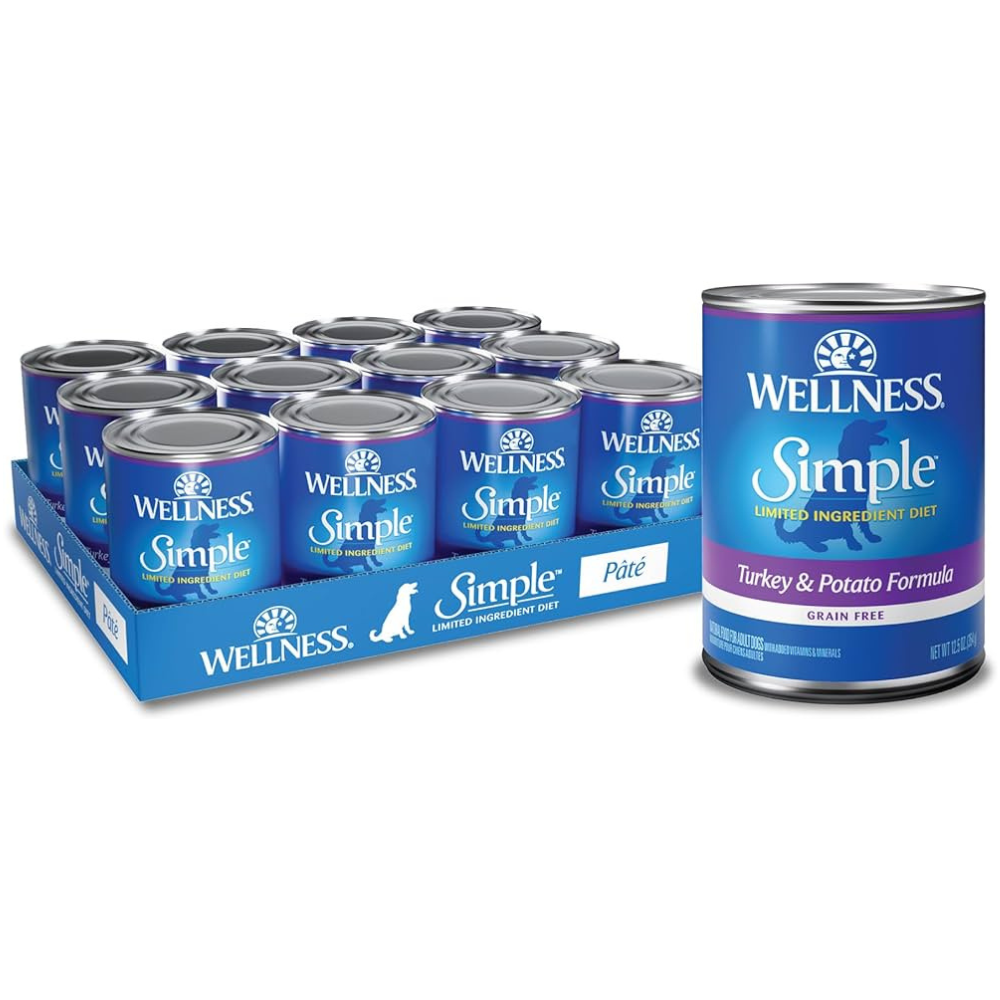
The best limited ingredient dog food
Not only does this dog food contain a single protein source (making it ideal for pups with allergies), but it's also a grain-free and affordable option.
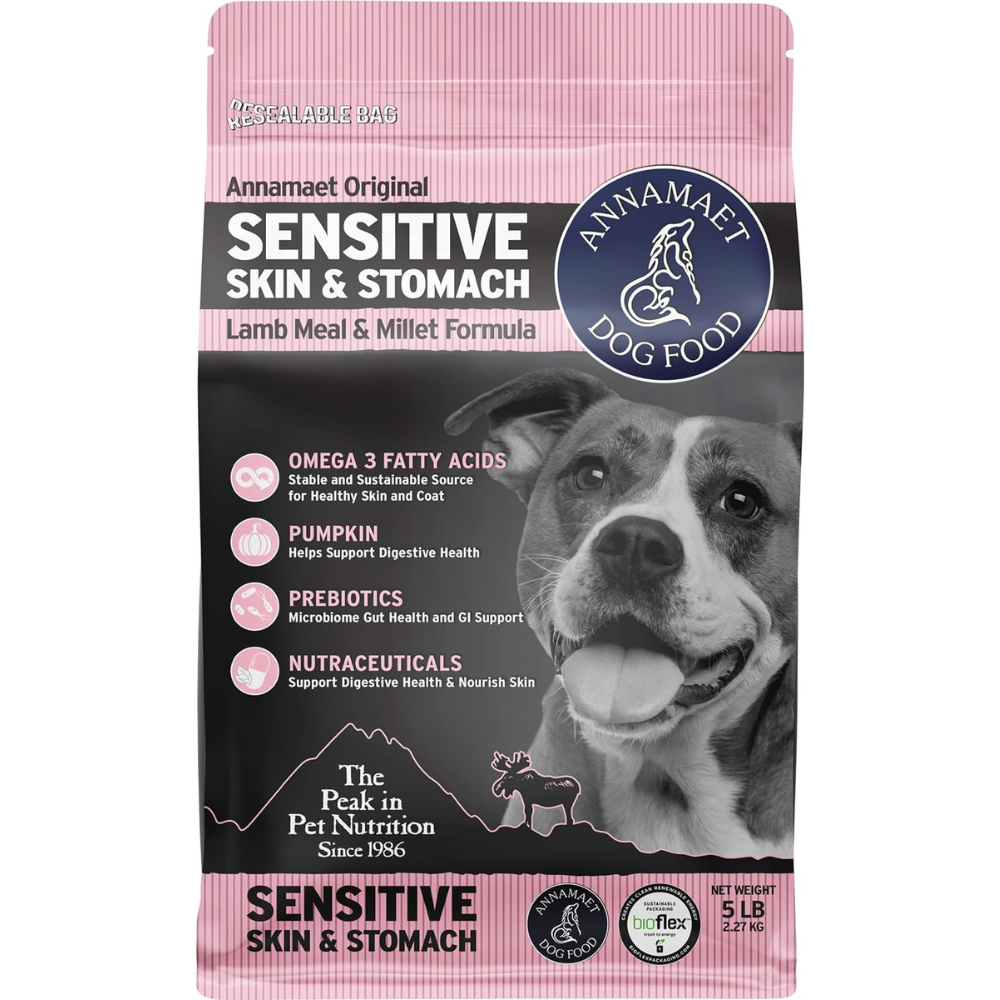
Best premium dog food for allergies
This lamb and millet formula contains omega 3 fatty acids, pumpkin and prebiotics - the perfect combination for dogs with sensitive skin and stomachs.
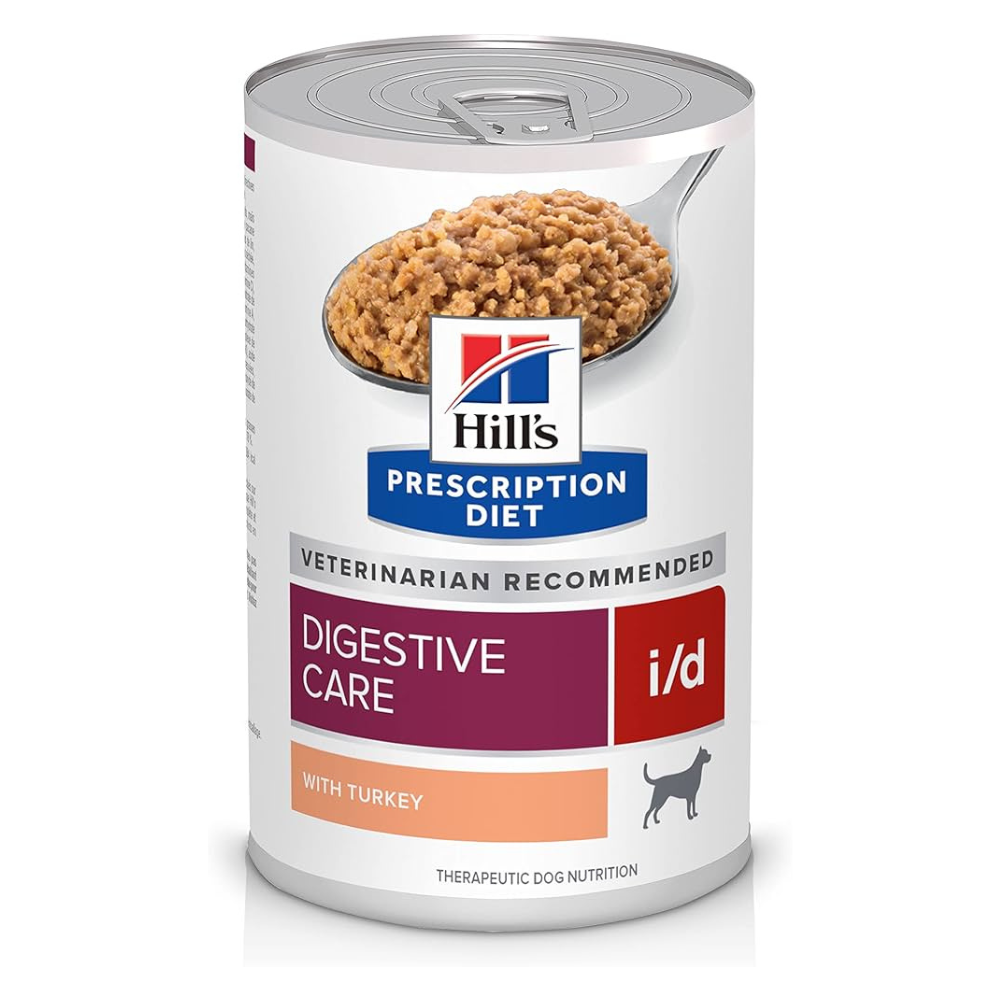
Best vet prescribed dog food for allergies
This vet-prescribed dog food contains prebiotic fibers for digestion, plus omega 3 and 6 fatty acids to support healthy skin and a shiny coat.
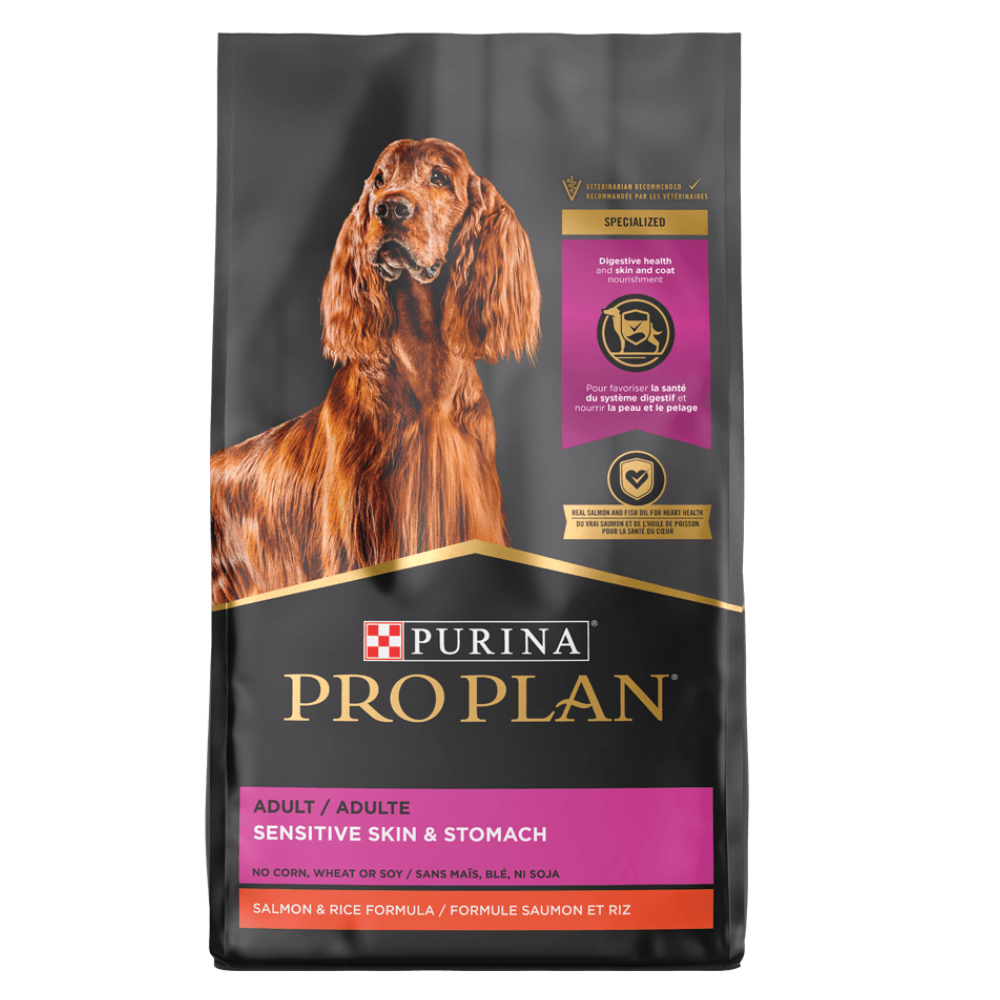
Best on a budget
This affordable dog food costs just $0.14/oz, making it perfect for those on a budget. Plus, it contains oatmeal to help with digestion and a source of omega-6 to help maintain a healthy coat.
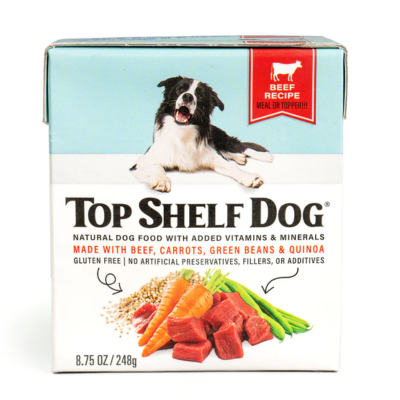
The best gluten-free dog food for allergies
On the hunt for gluten-free dog food? This high-quality beef dinner is packed with added nutrients and minerals, with beef as the number one ingredient. It also contains quinoa, carrots, and green beans for extra goodness.
The best dog foods for allergies we recommend in 2024
Best overall
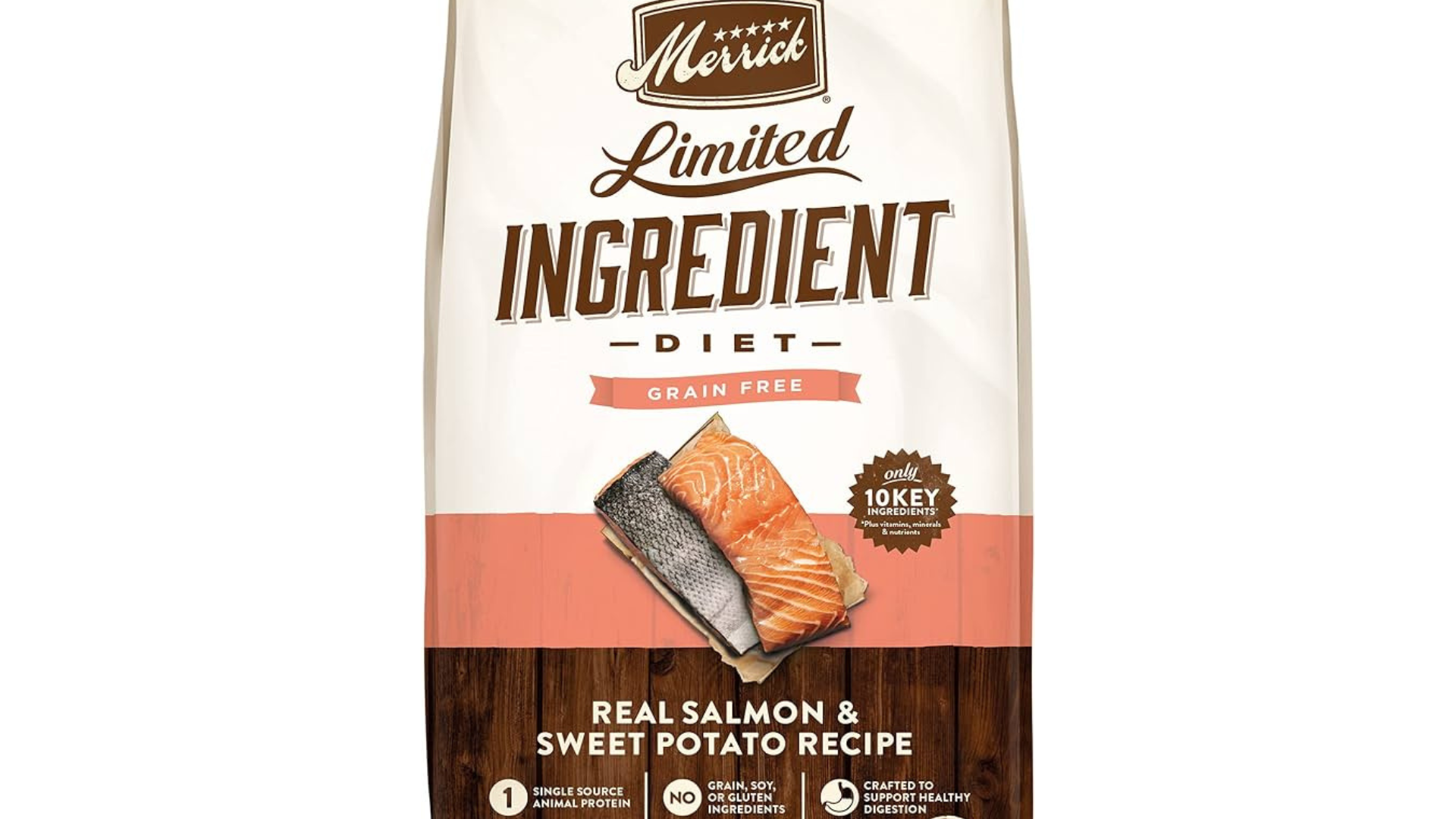
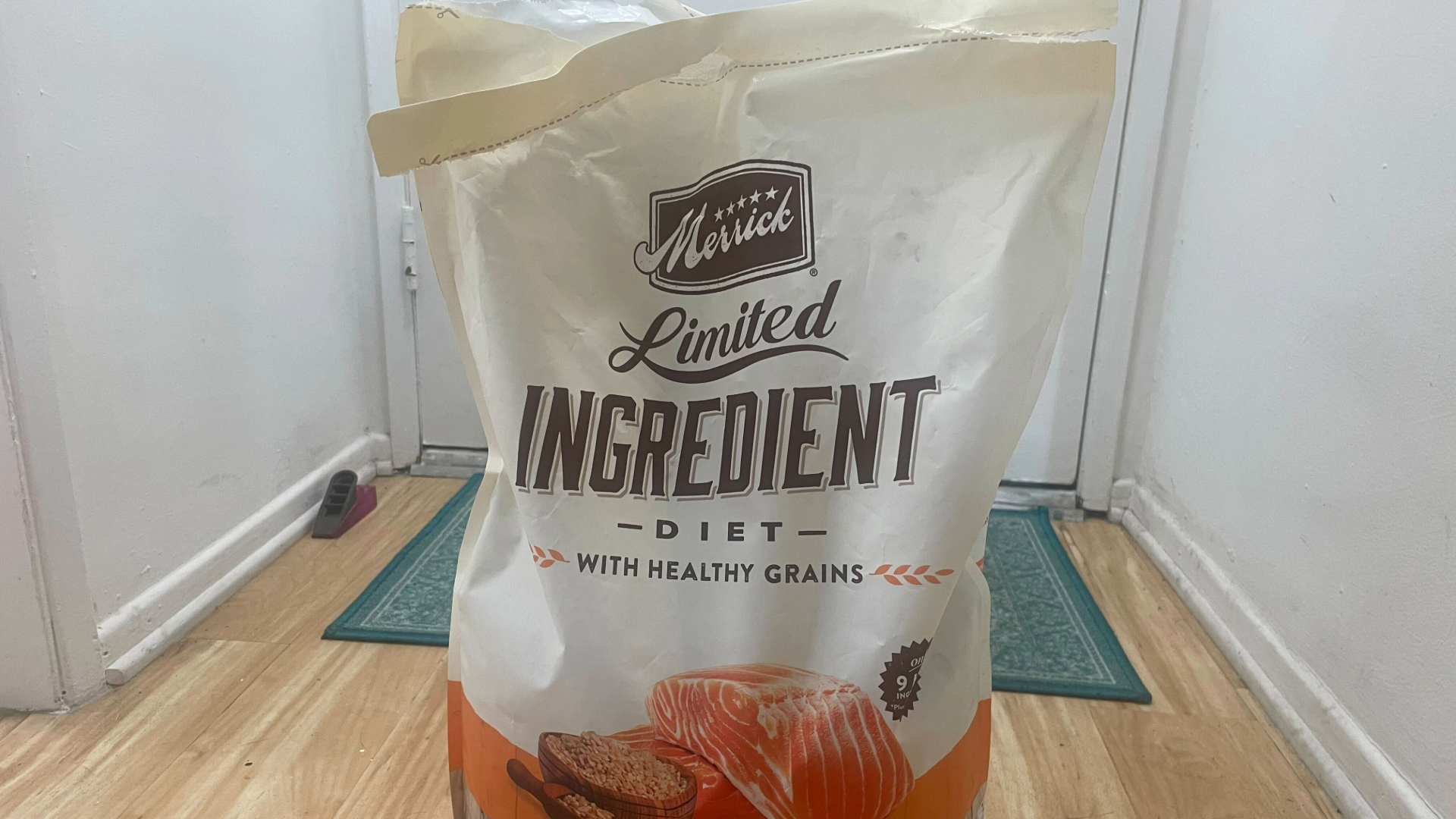

1. Merrick Limited Ingredient Real Salmon & Sweet Potato Dry Dog Food
Our expert review:
Specifications
Reasons to buy
Reasons to avoid
✅ You want a dry food that has limited ingredients: Thanks to its limited protein source, there are less chances of a food allergy.
❌ You don't want any odors: Since this food has a slightly fishy smell and the packaging is not resealable, you might want to avoid this one if smell is a big issue for you. However, you could always invest in a storage bin or bag clip.
🔎 Merrick Limited Ingredient Real Salmon & Sweet Potato Dry Dog Food: Containing omega 3 and 6, this food is great for helping with inflamed skin. If your dog is prone to allergies, this might be the one for you due to its limited protein sources that reduce that risk.
Our tester Sarah reported back that her dog loved the Merrick Limited Ingredient Dry Dog Food. Despite not being the biggest fan of salmon products usually, this one went down a treat and Duke the dog “absolutely loved it”. He has slight digestive issues, and Sarah notes that this food helped his tummy while maintaining his weight.
Duke normally likes his kibble with some broth or water mixed in, but as Sarah poured the food into his bowl, he had already stuck his head in and started tucking in. Sounds like a winner to us!
She says: “He finished it right away. A week later, he is still eating it with great fervor (he usually gets sick of the same food over and over, but hasn’t gotten sick of this yet which is amazing!)”
Sarah says this food is well worth the cost. However, the packaging is a bit tricky to store due to it being so big and bulky, and the bag is not resealable.
Sarah says: “This makes it really difficult during feeding time, but not enough to be a hindrance to the quality of this product. It does have a slight fishy smell, which is also why a Ziploc seal or some type of seal would be best for this type of dog food. I found myself having to make extra effort sealing it each time and is something I have to do to avoid the fish smell from leaking out.”
Dr Joanna Woodnutt says: "This range contains limited protein sources, reducing the chance of a food allergy. The inclusion of fish oils and flaxseed adds omega 3 and 6, which have anti-inflammatory properties in the skin.”
Best limited ingredient
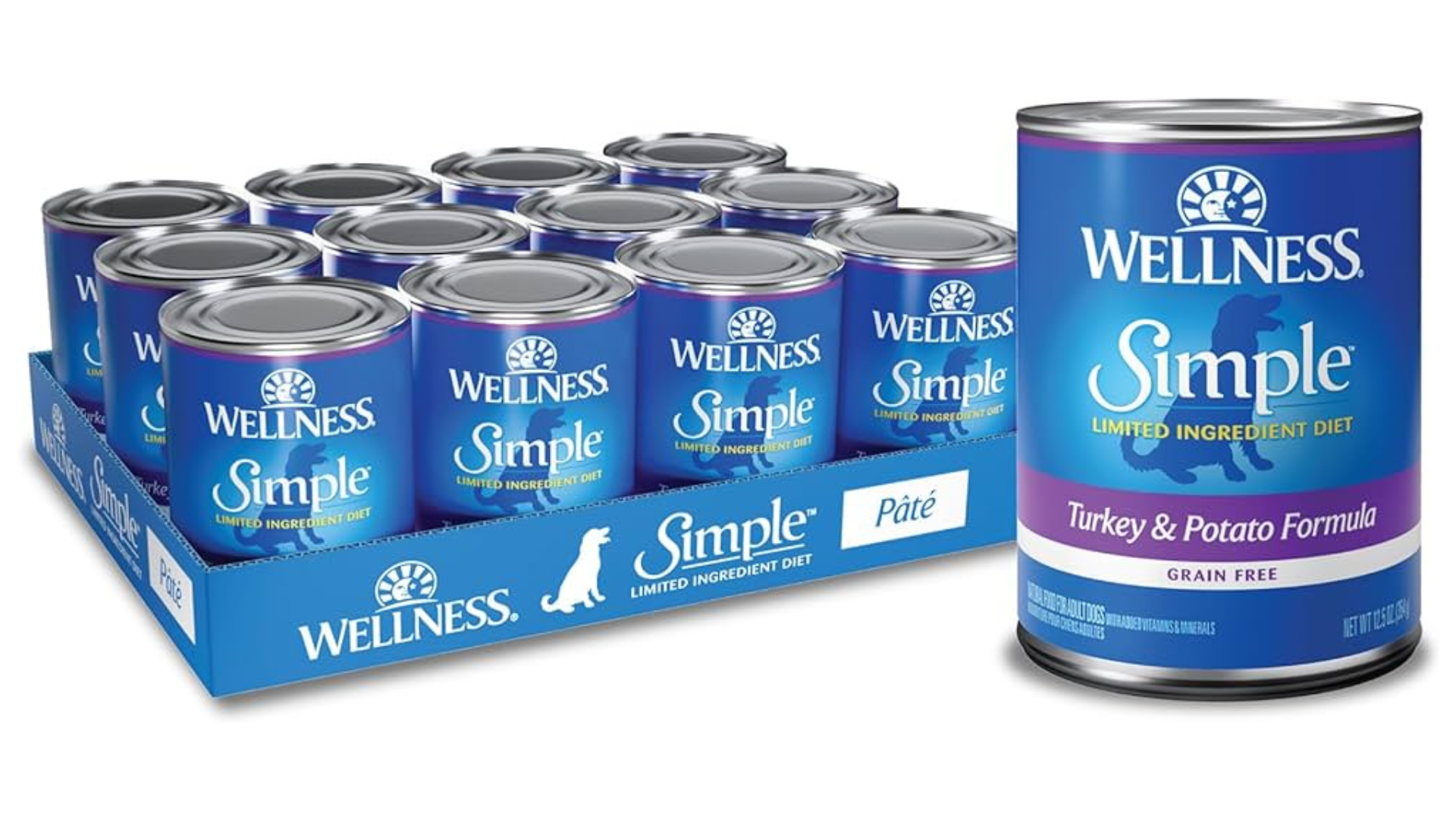
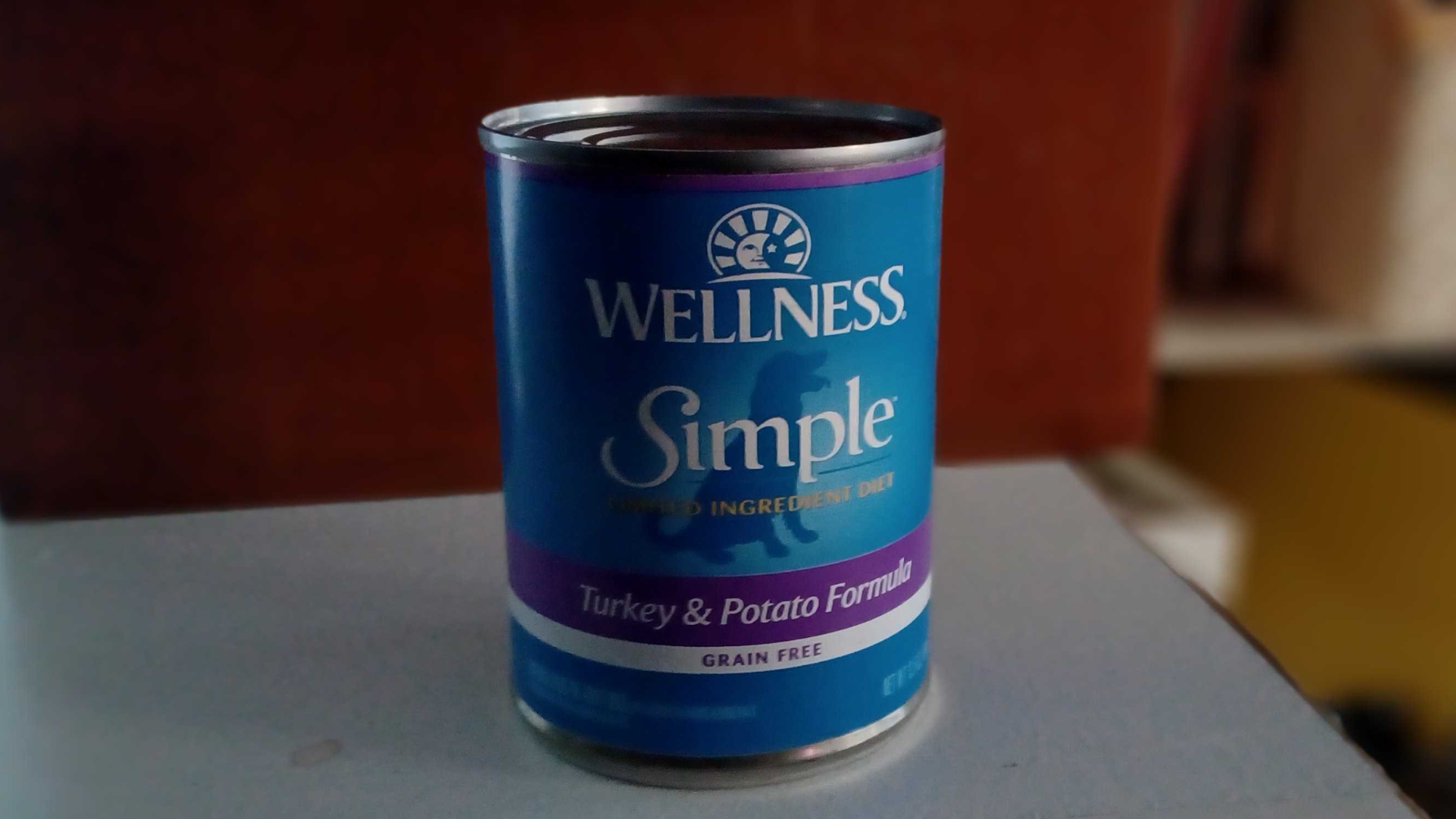
2. Wellness Simple Limited Ingredient Diet Grain-Free Turkey & Potato Formula Canned Dog Food
Our expert review:
Specifications
Reasons to buy
Reasons to avoid
✅ You're looking for wet food with limited ingredients: If your dog isn't a fan of kibble, they'll probably prefer this one a bit more. Since it contains only one protein source, there's less chance of a food allergy.
❌ Your dog has an allergy to turkey or chicken: Stay clear of this one if your dog has either of those allergies. Since turkey cross-reacts with chicken, it might not be suitable for your pooch.
🔎 Wellness Simple Limited Ingredient Diet Grain-Free Turkey & Potato Formula Canned Dog Food: If your dog doesn't have an allergy to turkey or chicken, this budget-friendly food could be perfect for them. It's grain-free, has limited ingredients, and contains ground flaxseed (renowned for its anti-inflammatory properties).
On the hunt for a limited ingredient dog food? This could be the one for your pooch. Our tester Michael tried the turkey and potato flavor out and says his dogs, Tito and Petey, loved it. The pair rarely eat dried food in one sitting, but they chow this one down every time it’s placed in front of them.
For those worried about the bad smells that canned foods often have, you’ll be pleased to hear that this doesn’t have one, according to Michael.
Tito and Petey previously suffered from itchy skin, but Michael reports that this hasn’t occurred since giving them the food. While the dogs are big fans of the flavor, our tester says it’s a little expensive at over $4 per can. However, they'll go through two cans between them over the course of three days. While the cans are easy to store, they're not resealable, so you might need to buy a lid cover or a storage tin.
Dr Joanna Woodnutt says: “These limited ingredient diets only contain one protein source, meaning they’re more suitable for dogs with food allergies. The ground flaxseed is a source of anti-inflammatory Omega-3 fatty acids.”
Best premium food
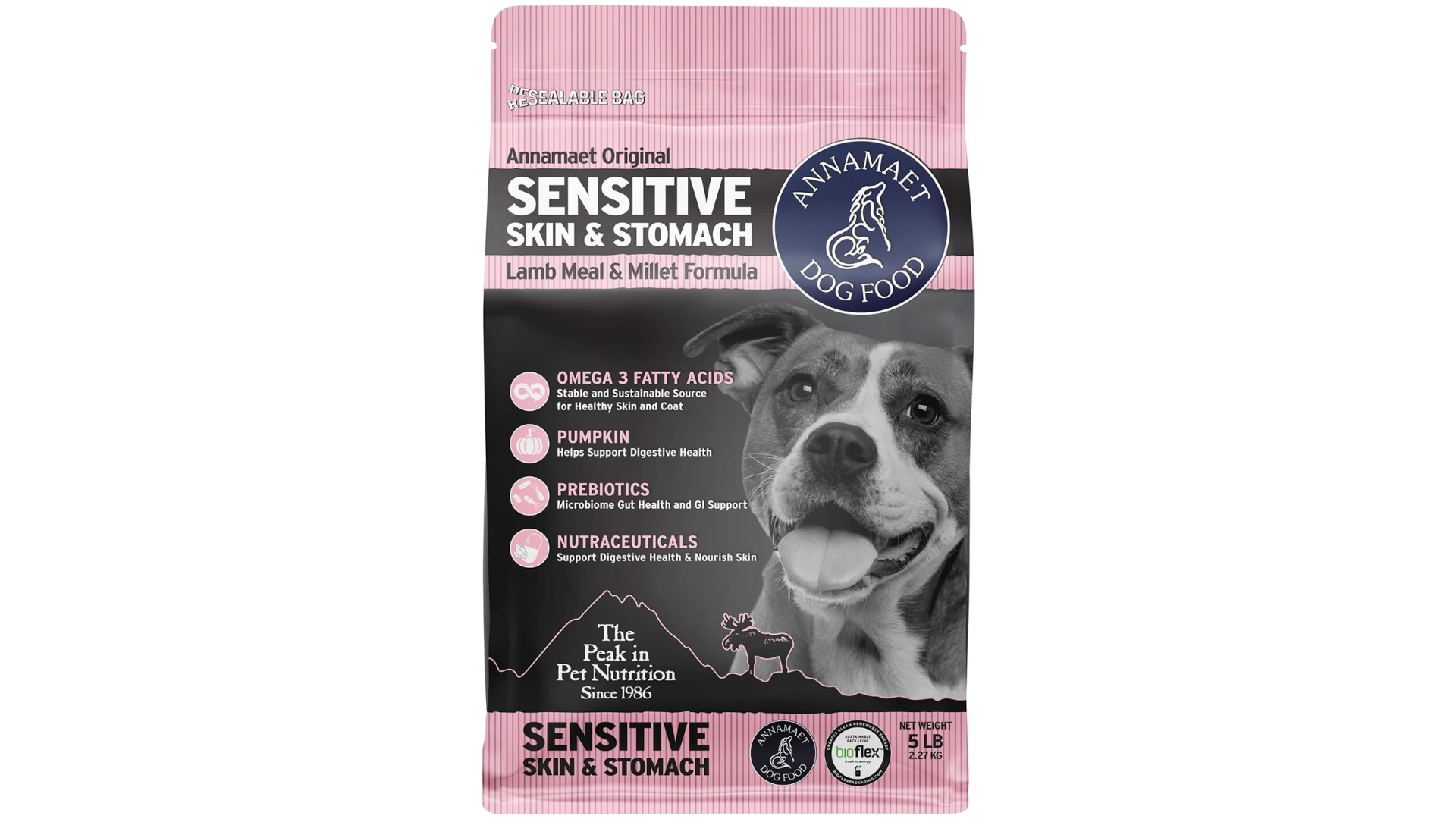
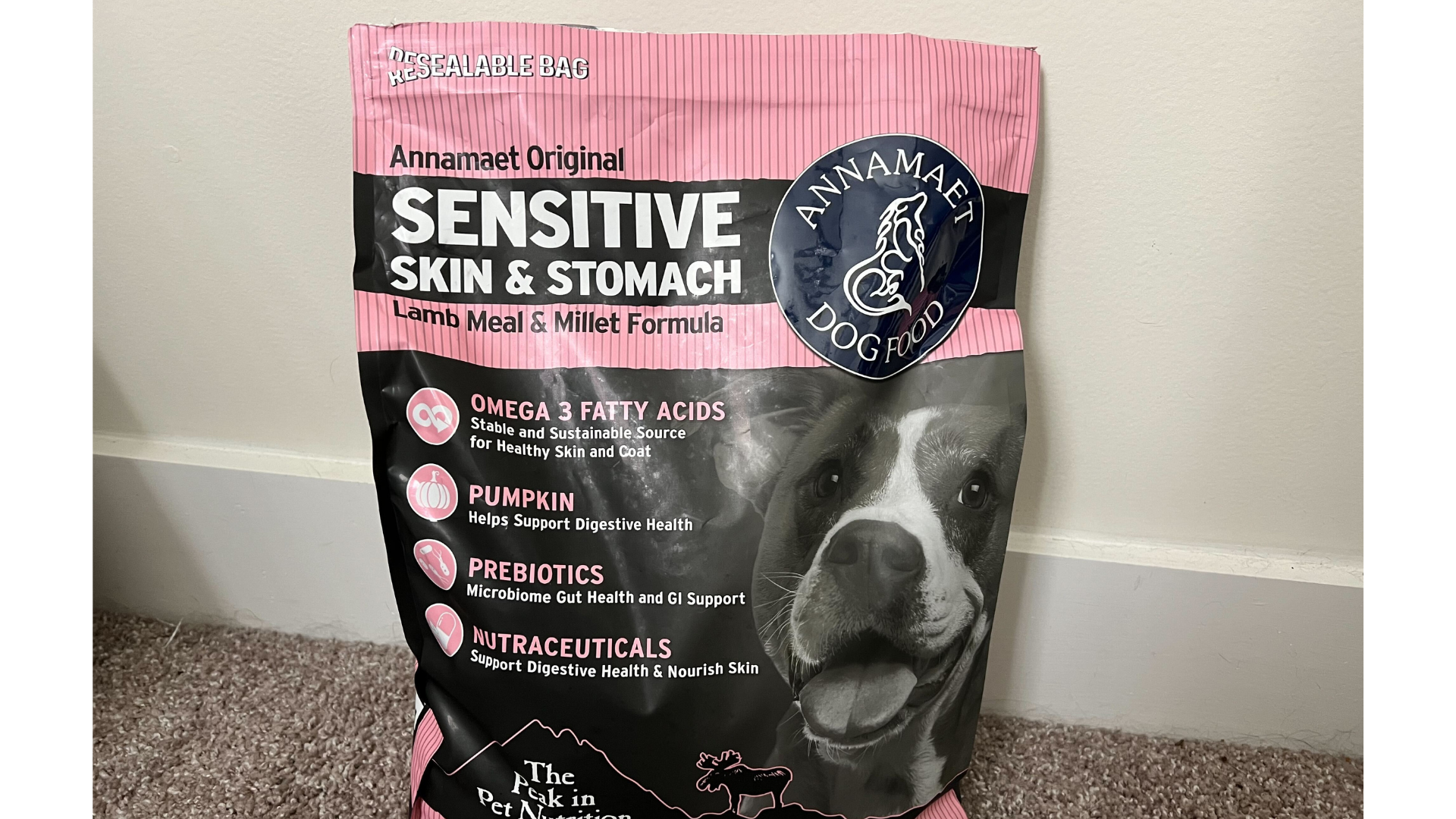
3. Annamaet Original Sensitive Skin & Stomach Dry Dog Food
Our expert review:
Specifications
Reasons to buy
Reasons to avoid
✅ Your dog has sensitive skin: It contains menhaden oil, an omega-3 essential fatty acid that's well-known for its anti-inflammatory properties for the skin.
❌ You're on a budget: This dog food has lots of benefits, but it's the priciest option on this guide and will set you back $4.25/lb (for a 12lb bag).
🔎 Annamaet Original Sensitive Skin & Stomach Dry Dog Food: There are lots of reasons to love this dog food, from its anti-inflammatory ingredient to its delicious flavor (according to Duke the dog). If you don't mind spending a little more, it's a great option.
Containing coconut oil for digestive issues and an omega-3 fatty acid for skin health, this dog food promises to “support digestive health and nourish skin”. But does it really live up to this? Pet parent Barbara put it to the test on her dog.
The price point may be slightly higher than the others in this guide, but Barbara says it’s definitely worth the money for the quality. To her, the cost "makes sense". Her dog loves it and immediately started eating it when she first introduced it to his diet.
It comes in a compact bag, with no extra unnecessary packaging, which means you don’t have to worry when it comes to storage. Plus, the bag is resealable meaning no unpleasant smells are going to escape into your home.
Whilst it’s not the easiest to portion and doesn’t come with a scoop, the bag does have a chart to help you with this.
Overall, Barbara says: “This is definitely suitable for dogs with sensitive stomachs.”
Dr Joanna Woodnutt says: “This diet contains menhaden oil, a source of essential fatty acids known to have anti-inflammatory effects on the skin.”
Best vet prescribed food

4. Hill's Prescription Diet i/d Digestive Care with Turkey Wet Dog Food
Our expert review:
Specifications
Reasons to buy
Reasons to avoid
✅ You're looking for a vet-prescribed dog food: You won't be able to buy this without a vet prescription, which gives you peace of mind that it's the right match for your dog.
❌ You're looking for a budget option: Whilst this isn't the most expensive on the list, you will need to pay for a vet appointment to get a hold of this dog food which is another added cost.
🔎 Hill's Prescription Diet i/d Digestive Care with Turkey Wet Dog Food: It might not be the most convenient way to buy your dog food, but getting your vet's stamp of approval is always important when transitioning onto a new dog food - especially if they have an allergy or sensitivities.
This vet-prescribed food might be a little harder to get your hands on, but promises to help settle digestive issues. Our tester Sarah says it’s a great product that really helps her dog Duke with his digestion problems. However, since you need to get a prescription each time you buy it, it’s on the pricier side since there’s the added cost of booking a vet appointment.
You’ll be pleased to hear that the food doesn’t have an unpleasant odor, which is a good thing since the packaging is not resealable.
Sarah says: “My dog loves this brand and it really helps his system get back to normal when experiencing digestive issues (diarrhea, vomiting, etc.)”
So how does it compare to the Merrick Limited Ingredient Real Salmon & Sweet Potato Dry Dog Food that Duke also tried?
Sarah says: “Both of them seem to have limited ingredients which is a plus for me when trying to feed my dog. I'm not looking to feed Duke a ton of fillers and preservatives. He does seem to love the Merrick kibble more than his other dry food so that may be a testament to how fresh the kibble is!”
Best on a budget
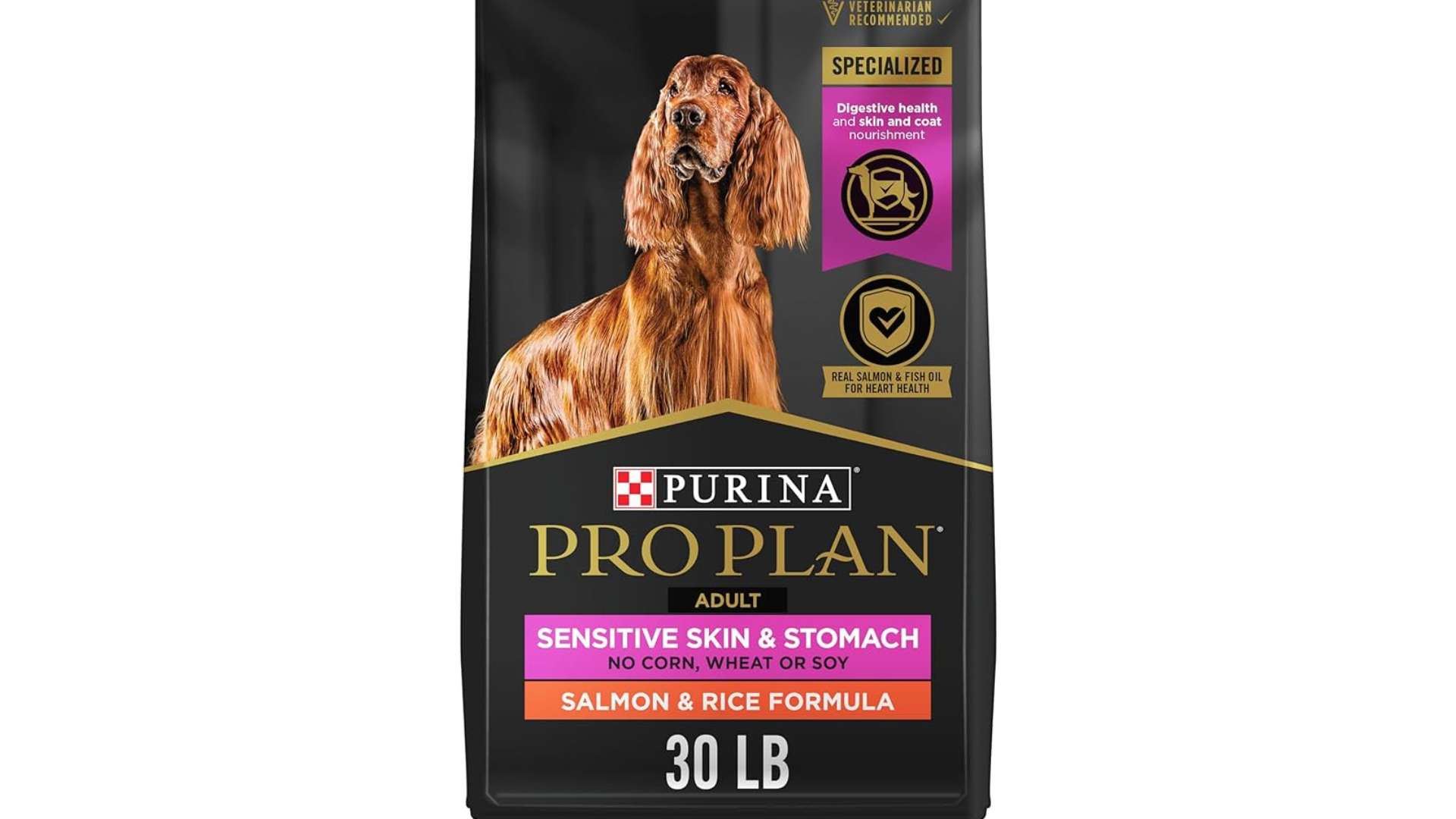
5. Purina Pro Plan Adult Sensitive Skin & Stomach Salmon & Rice Formula Dry Dog Food
Our expert review:
Specifications
Reasons to buy
Reasons to avoid
✅ You're on a budget: This dog food ranks at number one on this guide in terms of affordability, costing just $0.14/oz for the largest size.
❌You want something easy to store: Unfortunately, the packaging is not resealable which might make it trickier to store. However, you could buy a storage bin or bag clip to fix this problem.
🔎 Purina Pro Plan Adult Sensitive Skin & Stomach Salmon & Rice Formula Dry Dog Food: Containing oatmeal for digestion and fish oil for omega-3, this dog food is great for maintaining a healthy coat and is gentle on the stomach.
Our tester Barbara also tried out the Purina Pro Plan Adult Sensitive Skin & Stomach Salmon and Rice Formula Dry Dog Food.
Containing salmon as the number one ingredient, plus sunflower oil, the brand states that this food is rich in omega fatty acids. This contributes towards to good joint health and promotes a healthy coat, whilst the oatmeal is “gentle on the digestive system”.
Barbara says the quality and quantity of the food are worth the price tag and that her dog loves the taste. “She has always been excited to eat it”, she says.
The downsides are that the packaging is not resealable, which makes it a little harder to store, and it’s not the easiest to portion as it doesn’t come with a scoop. However, there is a chart on the back to help you if you’re not sure about portion sizes. Unlike the Annamaet food that Barbara also tested, she says that this one has quite a bit of extra packaging, meaning it might not be the most eco-friendly.
So how do the two compare?
Barbara says: “[In terms of] quality, I think they are very similar. The Annamaet food has a stronger smell but since the bag reseals, it doesn’t linger. I would say you get more for your money quantity-wise with the Purina Pro bag. I think both are excellent choices for your pup. It just comes down to which one your dog will enjoy more!”
Best gluten-free dog food for allergies

6. Top Shelf Dog Beef Dinner
Our expert review:
Specifications
Reasons to buy
Reasons to avoid
✅ Your dog has a gluten intolerance: If your pup has an allergy or sensitivity to gluten, this dog food is a great choice.
❌ Your dog is allergic to beef: This isn’t a good option if your dog has an allergy to beef. Since beef and lamb allergies cross-react, you’ll want to avoid it if they’re allergic to lamb too.
🔎 Top Shelf Dog Beef Dinner: A tasty beef dinner that’s gluten-free and contains added nutrients and minerals. With beef as the number one ingredient (plus quinoa, carrots, and green beans) your pup is going to love it — our tester sure did!
Top Shelf Dog promises that even picky eaters will enjoy this beef dinner, but what did our tester think of it?
Kate said: “Both pups went right for it with no hesitation. Our pups really enjoy it and neither have had any tummy issues. We got the beef flavor, and we were able to clearly see the individual main ingredients in the food, which was nice.”
When it comes to choosing dog food, it’s always best that protein is the first ingredient. This means that it’s the most common ingredient as the label descends by weight. So, we were pleased to see that beef is number one in this dog food, followed by beef broth, carrots, green beans, quinoa, sunflower oil, and fish oil.
According to Top Shelf Dog’s website, they make the food using whole ingredients which are fortified with vitamins and minerals. This is important for your dog’s growth and development, especially if you’re feeding a little one.
We love the fact that it’s shelf stable and can last up to two years after the production date unopened. Whilst the packaging isn’t resealable, Kate said that you can fold the top down to close it and it doesn’t have a noticeable odor. The food doesn’t come with a measuring scoop but she said that it was “easy to portion” as a topper.
Best free-range food
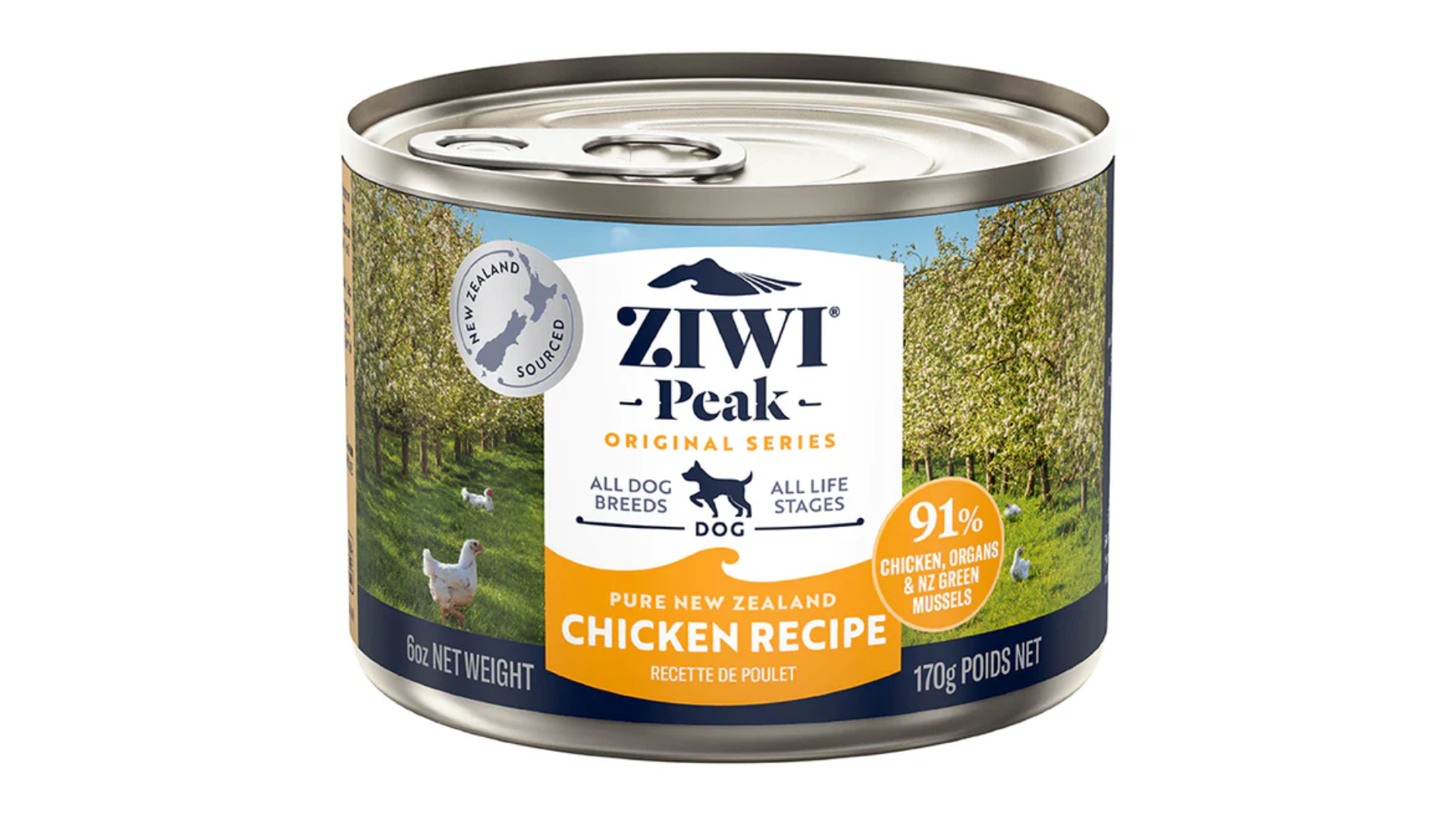
7. ZIWI Peak Chicken Recipe Canned Dog Food
Our expert review:
Specifications
Reasons to buy
Reasons to avoid
✅ You want a free-range option: ZIWI sources its chicken from free-range farms in New Zealand which are independently audited and certified as humane.
❌ Your dog has inflammation issues: Whilst there are lots of benefits to this dog food, it might not be the best for some dogs with inflammation issues. Our tester reported that it disrupted one of her dog's bowels and that vet-recommended products worked best for them.
🔎 ZIWI Peak Chicken Recipe Canned Dog Food: This grain-free dog food is the perfect choice for pet parents concerned about where the ingredients come from. You'll be pleased to hear that the chicken meat comes from audited free-range farms. Plus, our tester's dogs loved the taste of it.
Our tester Tiff tried this one out on her 14-year-old Morkie and four-month-old Lagotto Romagnolo. It was clear to see that her two pooches enjoyed the taste as they "absolutely inhaled" it. It came as a shock to Tiff as one of her dogs usually leaves their food for hours before finishing it - but it wasn't the case with this one.
Since Tiff has a puppy (eating more than he would in adult stages), it's hard for her to tell if it's worth the money based on quantity as he goes through food so quickly. However, she confirms that the quality of it is "great".
In comparison to her regular food, Tiff says: "Our dogs normally eat the Just Food For Dogs Chicken and Rice pantry recipes, which is as outstanding as it is expensive, so I’d say if we’re willing to splurge on that brand, I’d be willing to splurge on Ziwi."
The food is available in 13.75-oz cans as well as a smaller size of 6-oz. Tiff tried out the latter and says it is "exceptionally easy to store". She also notes that there were no smells and she could even put the leftovers in her fridge.
Tiff reports back that there wasn't a measurement scoop provided, so she had to use wooden chopsticks to get the food out (to avoid metal on metal).
Tiff says whilst the Ziwi Peak Chicken Recipe Canned Dog Food is great, she prefers the Just Food For Dogs option.
She says: "We noticed both dogs’ bowel movements were slightly affected by the changed food. Our Morkie had to stop Ziwi as it disrupted her bowel movements and they were softer and greener than normal—she is 14 years old and has been fed Just Food For Dogs her entire life, so we felt it was better not to continue the change.
"Our Lagotto absolutely loved the food and he had regular bowel movements but we did notice they were a bit softer and stinkier than normal. This is likely just a personal preference since we’ve had long and positive experiences with a different brand, which multiple vets have recommended to us for our Morkie, who has had some health issues and signs of inflammation in the past—but if I ever needed a backup brand, I’m extremely happy with the Ziwi Peak Chicken recipe! "
How to choose the best dog food for allergies
If your dog seems more interested in pawing at his ears or scratching her skin than hanging out with you and you’ve ruled out other causes, then it could be time to consider experimenting with their diet.
But with as many free-from foods on the market for dogs as there is for people, knowing where to start can be daunting. Thankfully, we’ve come up with a few simple guidelines that will help point you in the right direction.
Look for products that have short ingredient lists, generally with one form of protein and one form of carbohydrate which makes it easier to identify the potential allergen. While there are both risks and benefits, raw dog food is another option worth looking into. With few ingredients and zero additives, our guide to the best raw dog food is a great resource if you’re not sure where to start.
According to Dr. Joanna Woodnutt, “A good diet for allergies has a single protein source, such as lamb, and a single carbohydrate source. This reduces the chance of an allergen being present. If you don’t know what your dog is allergic to, the diet should contain a novel protein - one your dog hasn’t encountered before. Unusual proteins like ostrich and bison are sometimes used for allergy diets for this reason.”
Novel proteins and other ingredients can work well for a lot of dogs as they won’t have been over-exposed to them in the past. Think venison, rabbit, kangaroo, pheasant and bison, and gluten-free ancient grains and seeds like quinoa, millet, and chia.
Antioxidants from fruits and vegetables and Omega-3 fatty acids are great additions to your pup's diet and are well worth keeping an eye out for. "Dog foods high in omega 3s will also help the skin by reducing inflammation and building a healthier skin barrier," says Dr. Joanna Woodnutt. You'll also want to look for added vitamins, minerals, prebiotics and probiotics. Vitamins C and E and probiotic strains like lactobacillus and acidophilus are particularly great for soothing the GI tract and ensuring good digestive health.
Woodnutt also recommends considering opting for a hydrolyzed diet. "The proteins are too small to cause an immune reaction," she explains. "They are great to use when the dog’s dietary history is unknown. They are also produced in a clean factory, to reduce the risk of cross contamination, as studies have shown the ingredients list on the back of the pack isn’t always accurate when it comes to what proteins could be inside."
Finally, if you’re noticing your dog displaying any of the symptoms of a possible allergic reaction be sure to consult your vet who will be able to help identify the cause and recommend the best course of treatment.
How we tested the best dog foods for allergies
We searched high and low to bring you the very best dog food for allergies. After hand-selecting our favorites, we passed them over to our team of experts who are all dog parents. Their pups got down to business and tested each and every one of the foods listed in this buying guide (it's hard work but someone's got to do it!) Here are some of the things we considered when ranking these products:
- Taste: Our fur babies deserve to be fed like royalty. Taste is a huge factor when it comes to buying dog food so we made sure our testers actually wanted to eat the food.
- Benefits: If you're switching over your dog food, you want it to be worth it. That's why we scoured the ingredients to ensure they have health benefits for your pup. We then asked a vet to assess the quality of the ingredients.
- Value for money: No matter what your budget is, we want to make sure you find high-quality dog food that's right for your pet. We tried to include a range of price points so it's accessible for everyone.
What foods should dogs with allergies avoid?
According to VCA Animal Hospitals, the most common food allergens in dogs are proteins, particularly those found in beef, chicken, chicken eggs, dairy, soy, and wheat gluten.
However, they note that almost any food ingredient has the potential to trigger an allergic reaction and while protein is the most common cause, other substances, such as artificial colors and preservatives, can also be responsible.
While it’s tempting to just start removing certain foods from your dog’s diet, it’s important that you seek the specialized advice and guidance of your vet to avoid accidentally omitting vital vitamins and minerals that your pup needs to thrive.
Your vet will be able to run tests that accurately determine exactly which ingredients are causing issues for your dog and work with you to formulate an appropriate diet for them.
Dr. Woodnutt says: “To maximize the chances of success, remember that you must avoid extra treats or titbits, as these could contain meat proteins you are trying to cut out. For example, if you are feeding your dog a carefully chosen trout and sweet potato-based pet food, but still giving him chicken-based chews or roast dinner leftovers on the side, this won’t be a fair test of the diet’s success. Your vet is the best person to ask for advice on how to do a proper dietary trial, so don’t hesitate to discuss it with them.”
What is the most common dog allergy?
As we’ve seen, food allergies in dogs are not as common as we might think, with the AVMA estimating that only 0.2% of pups will suffer from an allergic reaction that’s been triggered by something they’ve consumed.
So, if food allergies aren’t all that prevalent, what is the most common dog allergy? Well, according to a 2018 State of Pet Health Report from Banfield Pet Hospital, found that flea allergies in dogs have increased by 12.5% over the past 10 years, with environmental allergies up 30.7%.
As always, if you suspect your canine companion is suffering from an allergy, be sure to consult your vet who will be able to let you know exactly what you’re dealing with and outline an appropriate course of treatment.
Is dry or wet food better for dogs with allergies?
There is no difference between wet and dry food when it comes to allergies, says Veterinary Surgeon Dr Hannah Godfrey. “What’s important is avoiding the allergen (or allergens) that’s causing their reaction. Whether the dog food is wet or dry is unimportant, as long as it doesn’t contain the ingredient that they’re allergic to.”
You may have seen your dog show symptoms after eating wet food, only for them to fade away when you switched to dry, or vice versa, but this is just down to which allergens each food contains, not the type of food.
You can get allergy tests done to determine what ingredients your pet is allergic to, but as Dr Godfrey explains, “allergy tests aren't perfectly reliable, and they can be costly. Therefore, you may choose to skip this step and choose an allergen-free prescription diet to use as your dog's only food intake to see if their symptoms improve.”
Dr Godfrey goes on to explain that the majority of these diets use “hydrolyzation to ensure that the ingredients can't be recognized as allergens by your dog's immune system.”. Most of them are dry food based, which could be where this myth about dry food being better for allergies comes from, but there are wet food options out there too if your dog prefers that.
Which is the best meat for dogs with allergies?
Dr. Woodnutt says that dogs are usually allergic to meat that is common in everyday pet food (like chicken or beef).
She says: “This makes sense as many susceptible animals will need to have repeated exposure to the item they are allergic to before they develop their sensitivity. So, when choosing an alternative for your pet, I advise owners to opt for what is called a ‘novel’ protein.
“This is any protein source your pet is unlikely to have encountered before which may include duck, salmon, or venison. It’s important to check the ingredients list on your chosen manufactured dog food carefully though. While they may list ‘venison’ or ‘duck’ proudly on the front of their packet, some will still contain smaller amounts of other meat too which may defeat the purpose of your change in diet.”
Before switching up your dog’s diet, make sure you talk to your vet to get specific recommendations.

Megan is a Staff Writer on PetsRader, covering news, features and buying guides. She has a wealth of experience looking after animals, having grown up with dogs, cats and horses all of her life. She’s particularly interested in pet happiness and behavior, which she loves to research in her spare time. You’ll often find her watching webinars on reactivity in dogs or researching cat body language. She loves going the extra mile for her cats Chilli and Nala (who also help out with testing the best products for our buying guides).

Dr Joanna Woodnutt is an experienced vet who qualified at the University of Nottingham and practiced companion animal medicine in the Midlands, UK. She enjoys the consulting side of things, and helping clients with medical problems and understanding their pets better.

Hannah graduated from the Royal Veterinary College in 2011 and began work straight away at a busy mixed practice. Initially, she treated all species, but focused on small animals from 2014. She has a passion for soft tissue surgery, ultrasound, and canine and feline dentistry, having completed additional training in these areas.
Get the best advice, tips and top tech for your beloved Pets

Megan is a Staff Writer at PetsRadar, covering features, reviews, deals, and buying guides. She has a wealth of experience caring for animals, having grown up with dogs, cats, horses, guinea pigs, and more throughout her life. She studied BA Journalism at the University of Westminster, where she specialized in lifestyle journalism and was editor of Smoke Radio’s lifestyle website. Megan works alongside qualified vets and accredited trainers to ensure you get the best advice possible. She is passionate about finding accurate and helpful answers to your pet-related questions.
